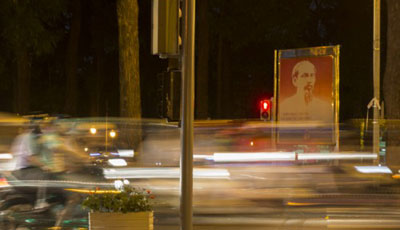By Liz Chilsen, Chicago Now
This summer I was in Saigon Vietnam doing research for a class I’ll be teaching in Southeast Asia next summer. I am very excited about this class. Southeast Asia has long had a complicated pull on me, sparked by the U.S. war in Vietnam which raged during my early childhood. Complexities from that conflict are very much with us still – weaving and rippling through our lives across generations and continents. It’s hard to put a finger on, but out of that complexity, these 10 things rise to the surface.
Motorbike traffic passing a billboard image of Ho Chi Minh on a Saigon evening.

1. Saigon. The name. Everybody calls it Saigon instead of its official moniker, Ho Chi Minh City.
2. Sophie Hughes’ art tour: Sophie is a Brit whose family comes from Wisconsin, and she’s made it her business to be an expert on art in Vietnam beginning with the French colonial period. She covers artists of the French colonial beaux arts school founded in the 1920’s, and also the artists of the resistance during the 1940’s to the 60’s. She offers poignant insights into the artists who followed the troops during first the French war, and then the American war (which we call the Vietnam War), and propaganda posters made during that time. She describes the arts scene in Vietnam immediately following the war, and finishes up with contemporary art in Saigon today. Hard to believe she can cover so much territory in a half a day, but she does. And with deep insight, good humor, and passionate regard for the people and work she discusses. Sophie’s Tour visits art galleries and museums where she’s chosen individual works to discuss, and she enhances her points with a selection of further works displayed on her ever-present iPad. Highly recommended if you’re planning a trip to Vietnam. You can find her at sophiesarttour.com.
3. The French Colonial Buildings. I was intrigued that multiple people, independently of one another, spoke about the the soft yellow ochre paint on the official buildings. Each person wistfully described the ‘old’ yellow, and how the new color used in renovations just isn’t the same. The tenderness in their voices as they described that faded yellow paint was nostalgia, but also seemed something deeper: a reverence for the past perhaps, appreciation for delicate distinctions.
Two moments in the Reunification Palace:
4. Being in the modernist Presidential – or Reunification – Palace during a long rainstorm. It was a steady and constant deluge. And yet the sun shone brightly during at least half the storm. I went from floor to floor in the palace, peering out windows and off balconies trying to find a rainbow, but I never came across it there.
5. I did find the basement corridors though. The glossy battleship grey, the polished floors, narrow corridors with no end in sight, rotary dial telephones in pastel shades lined up on steel desks… Small rooms, their walls covered by maps of Vietnam and Indochina, Laos and Cambodia, showing battlefields and topography. There was a powerful sense of being in a wartime bunker. All of this would be creepy under any circumstance, but especially so when you’re holed up during a torrential tropical rainstorm.
Read the full article by Liz Chilsen from Chicago Now.

